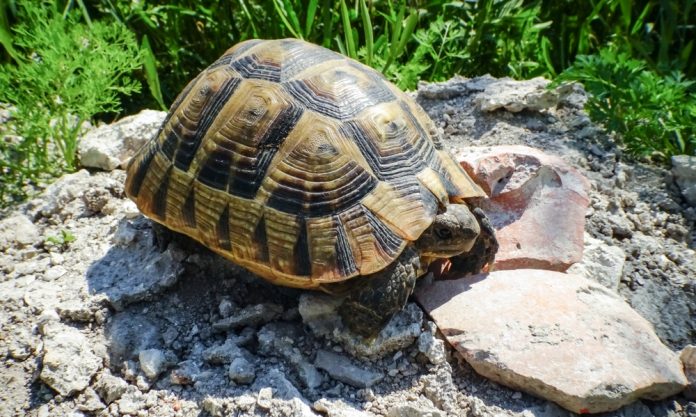Hermann’s Tortoises (Testudo hermanni) are beloved pets known for their gentle nature and striking shell patterns. To ensure they thrive, owners must provide proper care and attention. This article offers a comprehensive care guide for Hermann’s Tortoises, covering crucial aspects like diet, habitat, and health management.
Understanding Hermann’s Tortoises
Natural Habitat
Hermann’s Tortoises are native to Mediterranean regions, where they thrive in warm, dry climates with plenty of sunlight. They are found in countries like Italy, Spain, and Greece, living in scrublands, forests, and rocky hillsides. Mimicking this environment in captivity is essential for their well-being.
Physical Characteristics
These tortoises are medium-sized, typically reaching 7-9 inches in length. They have a domed shell with distinct yellow and black patterns, which makes them easily recognizable. Their friendly and docile nature makes them excellent pets for families and individuals alike.
Setting Up the Perfect Habitat
Enclosure Size and Design
Hermann’s Tortoises need ample space to explore and exercise. For indoor setups, a tortoise table or a large plastic tub with at least 3-4 square feet of floor space is recommended. Outdoor enclosures should be even larger, with secure walls to prevent escapes and protect from predators.
Substrate
Choose a substrate that mimics their natural environment. A mix of topsoil, sand, and coconut coir works well, providing a comfortable surface for burrowing. Avoid substrates like cedar or pine shavings, as these can be toxic to tortoises.
Temperature and Lighting
Maintaining the right temperature gradient is crucial. The basking area should be kept at 90-95°F, while the cooler side should be around 70-75°F. Use a basking lamp and a UVB light to provide necessary heat and UVB exposure, which is essential for calcium absorption and preventing metabolic bone disease.
Humidity
Hermann’s Tortoises prefer low to moderate humidity levels. Maintain humidity around 50-60% by misting the enclosure lightly and providing a shallow water dish for hydration. Ensure the enclosure has good ventilation to prevent mold and respiratory issues.
Diet and Nutrition
Primary Diet
Hermann’s Tortoises are herbivores with a diet consisting mainly of leafy greens, vegetables, and occasional fruits. Offer a variety of greens like dandelion, collard greens, and romaine lettuce. Vegetables such as carrots, squash, and bell peppers can also be included.
Calcium and Vitamin Supplements
Calcium is vital for shell health. Dust their food with a calcium supplement 2-3 times a week and provide a cuttlebone in the enclosure for additional calcium intake. UVB lighting helps them synthesize vitamin D3, but a vitamin supplement can be used occasionally to ensure they receive all necessary nutrients.
Health and Wellness
Regular Health Checks
Perform regular health checks to ensure your tortoise is thriving. Look for signs of illness such as lethargy, loss of appetite, or abnormal shell appearance. Regularly inspect their eyes, nose, and mouth for any discharge or signs of infection.
Common Health Issues
Hermann’s Tortoises are generally hardy but can suffer from respiratory infections, shell rot, and parasites if not properly cared for. Ensure their habitat is clean and well-maintained, and seek veterinary care if you notice any signs of illness.
Hydration and Bathing
Provide fresh water daily and offer a shallow dish for soaking. Regular soaking helps with hydration and digestion. Bathing your tortoise in lukewarm water once a week can also aid in maintaining shell and skin health.
Enrichment and Interaction
Enrichment Activities
Enrichment is essential for a tortoise’s mental and physical health. Add rocks, logs, and plants to their enclosure to create a stimulating environment. These elements encourage natural behaviors like climbing, hiding, and foraging.
Social Interaction
While Hermann’s Tortoises can be solitary, they do benefit from gentle handling and interaction with their owners. Spend time with your tortoise daily to build trust and familiarity. Avoid handling them too much, as excessive handling can cause stress.
Conclusion
Maintaining a healthy Hermann’s Tortoise requires a well-planned habitat, a balanced diet, and regular health checks. By following these expert care tips, you can ensure your tortoise leads a happy and healthy life.With proper care and attention, your Hermann’s Tortoise can be a delightful and long-lived companion.
